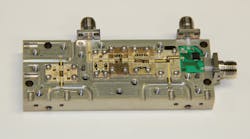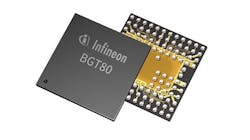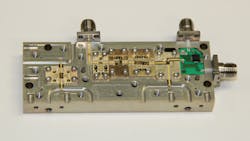This file type includes high resolution graphics and schematics when applicable.
Millimeter-wave technology is now spearheading a wide range of applications. Once reserved for military use, this technology has become more widely used today. Wireless backhaul is one such example, as V- and E-band backhaul networks have become increasingly common. Many small-cell deployments are utilizing these networks, demonstrating the importance of millimeter-wave technology. Automotive applications are another example, as radar detectors and electronic sensors are utilizing millimeter-wave frequencies.
Millimeter-wave technology is likely to become even more prevalent in the days ahead. The highly anticipated 5G networks are the main focus, as millimeter-wave frequencies are investigated for future 5G deployments. A large amount of spectrum is available in the millimeter-wave bands, potentially enabling the faster data rates that 5G will require. “The growth of the Internet continues to be exponential,” says Anuj Srivastava, president of Renaissance Electronics & Communications, LLC (REC). “We all want faster downloads, better connections, and the means to connect to all our data. 5G—and the millimeter-wave technology it will employ—could allow us to reach 10-Gb/s download speeds on our phone.”
Wireless Backhaul
Backhaul plays an important role in a network design, as it enables data to be transported from the core network to the edge network. Millimeter-wave technology has become a desirable option for wireless backhaul. As mentioned, V- and E-bands are now being utilized for small-cell deployments, allowing performance and cost benefits to be achieved. The V-band frequency range of 57 to 64 GHz has been allocated as an unlicensed frequency band, while the E-band frequency ranges of 71 to 76 GHz and 81 to 86 GHz have been allocated as lightly licensed bands.
Millimeter-wave backhaul offers several benefits—greater bandwidth, for one. Today’s network operators therefore have a number of reasons to consider millimeter-wave technology. “Because of the ever-increasing demand for data along with the dissociation of traffic revenues, network operators must look for cheaper and more efficient backhaul options without compromising stringent quality-of-service (QoS) requirements,” says Kerem Ok, product line manager of the microwave integration and VSAT group at Analog Devices. “Although traditional microwave will continue to play a major role in backhaul, the cornerstone of capacity enhancement will be millimeter-wave deployments—primarily E-band (71 to 86 GHz). It is expected to be the growth leader among all microwave/millimeter-wave bands, reaching 20% of all new deployments by 2020. E-band technology unlocks widely available spectrum to enable wireless throughput in excess of 10 Gb/s.”
Analog Devices offers a selection of monolithic microwave integrated circuits (MMICs) that are well suited for E-band backhaul applications. MMICs are available that cover 71 to 76 GHz, such as the HMC7543 power amplifier (PA) and HMC8120 variable-gain amplifier (VGA). The company also offers MMICs that span 81 to 86 GHz, such as the HMC8142 PA and HMC8121 VGA.
For its part, Infineon Technologies has developed millimeter-wave transceivers for wireless backhaul applications (Fig. 1). This product family includes models BGT60, BGT70, and BGT80. The BGT60 is a V-band transceiver chipset, covering a frequency range from 57 to 64 GHz. The BGT70 and BGT80 E-band transceivers span 71 to 76 GHz and 81 to 86 GHz, respectively. These transceivers are based on Infineon’s silicon-germanium (SiGe) technology.
Another company supporting backhaul applications is Peraso (www.perasotech.com), a fabless semiconductor company specializing in the development of 60-GHz wireless chipsets. Peraso offers products like the PRS1125, a single-chip millimeter-wave radio transceiver. This transceiver is well suited for small-cell backhaul, as well as 60-GHz point-to-point/point-to-multipoint radios. In addition to the PRS1125, Peraso offers additional 60-GHz products like the PRS2152 transmitter and PRS2153 receiver. These low-power millimeter-wave modules support channel bandwidths as high as 2 GHz.
In addition, the E-band diplexer from MTronPTI will find homes in backhaul applications. This diplexer has a low-band frequency range of 71 to 76 GHz, as well as a high-band range that covers 81 to 86 GHz. Its insertion loss is less than 0.65 dB in both bands. The diplexer also boasts more than 60 dB of transmit-receive isolation.
Automotive Radar
Millimeter-wave frequencies are also enabling other applications, such as 77-GHz automotive radar. NXP Semiconductors, which just recently completed its merger with Freescale Semiconductor, announced its new single-chip 77-GHz radar transceiver. Being roughly the size of a postage stamp, it can be invisibly integrated anywhere in a car. NXP says the chip can ultimately help to enable self-driving cars.
In addition to its wireless backhaul transceivers, Infineon Technologies offers integrated circuits (ICs) for 77-GHz automotive radar applications. The company’s radar system IC (RASIC) series is intended to provide customers with a system solution for 77-GHz automotive long-range radar (LRR) and mid-range radar (MRR) applications. This solution promises to slash the number of required components.
Millimeter-Wave Component Suppliers
Millimeter-wave components (as well as subassemblies) are offered by many suppliers to support a variety of applications. A notable example is SAGE Millimeter, which offers a selection of products including amplifiers, oscillators, control devices, frequency converters, and more. One recently released product is the SSR-9630831560-10-S1, which is a W-band receiver that spans 92 to 100 GHz. In addition, the SFA-106SF-S1 is an active X6 frequency multiplier covering an output frequency range of 90 to 98 GHz when driven by input frequencies ranging from 15 to 16.33 GHz.
For its part, Millimeter Wave Products Inc. (MI-WAVE) provides an array of products that operate at millimeter-wave frequencies. For example, the company has a line of ferrite components that includes isolators, circulators, polarization switches, and phase shifters. Among its many other millimeter-wave products are amplifiers, mixers, filters, and adapters. MI-WAVE can support both commercial and military applications.
Additional suppliers of millimeter-wave products include the aforementioned REC. Its subsidiary, HXI, offers a range of millimeter-wave components and integrated assemblies. Customers can select from components including amplifiers, mixers, detectors, and many more. In regard to integrated assemblies, the company can deliver products like receivers, transmitters, and transceivers. For example, HXI offers a transmitter that spans 70 to 77 GHz (Fig. 2). In addition, the company provides millimeter-wave radios for both V- and E-band applications.
Both millimeter-wave and terahertz products are available from Virginia Diodes, Inc. (VDI), which offers an assortment of higher-frequency devices and systems. Such products include receivers, mixers, detectors, and frequency multipliers. In addition, VDI provides test-and-measurement solutions for millimeter-wave and terahertz applications by offering extension modules for vector network analyzers (VNAs), spectrum analyzers, and signal generators. These modules can be used with standard test equipment to extend test and measurement capability to terahertz frequencies. Currently available extension modules can allow coverage of frequencies as high as 1.1 THz.
Given the wide range of millimeter-wave products that are available today, this article can only provide some examples. A large and growing number of companies are supporting the needs of applications that utilize these higher frequencies. As the usage of millimeter-wave frequencies continues to increase, we can expect to see additional products reach the market in the days ahead. New companies also will enter the fray. With the much-anticipated 5G on the horizon, many companies will focus more attention on millimeter-wave technology with the hope of delivering future cutting-edge performance.
This file type includes high resolution graphics and schematics when applicable.



